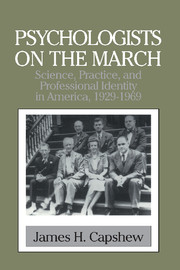Book contents
- Frontmatter
- Contents
- Acknowledgments
- List of Abbreviations
- Introduction: The Psychologists' War
- Interlude I
- 1 Growing Pains: After the Great War
- 2 Mobilizing for World War II: From National Defense to Professional Unity
- 3 Home Fires: Female Psychologists and the Politics of Gender
- Interlude II
- 4 Sorting Soldiers: Psychology as Personnel Management
- 5 Applied Human Relations: The Utility of Social Psychology
- 6 From the Margins: Making the Clinical Connection
- 7 Engineering Behavior: Applied Experimental Psychology
- Interlude III
- 8 A New Order: Postwar Support for Psychology
- 9 Remodeling the Academic Home
- Interlude IV
- 10 The Mirror of Practice: Toward a Reflexive Science
- 11 Beyond the Laboratory: Giving Psychology Away
- Interlude V
- Epilogue: Science in Search of Self
- Index
8 - A New Order: Postwar Support for Psychology
Published online by Cambridge University Press: 06 July 2010
- Frontmatter
- Contents
- Acknowledgments
- List of Abbreviations
- Introduction: The Psychologists' War
- Interlude I
- 1 Growing Pains: After the Great War
- 2 Mobilizing for World War II: From National Defense to Professional Unity
- 3 Home Fires: Female Psychologists and the Politics of Gender
- Interlude II
- 4 Sorting Soldiers: Psychology as Personnel Management
- 5 Applied Human Relations: The Utility of Social Psychology
- 6 From the Margins: Making the Clinical Connection
- 7 Engineering Behavior: Applied Experimental Psychology
- Interlude III
- 8 A New Order: Postwar Support for Psychology
- 9 Remodeling the Academic Home
- Interlude IV
- 10 The Mirror of Practice: Toward a Reflexive Science
- 11 Beyond the Laboratory: Giving Psychology Away
- Interlude V
- Epilogue: Science in Search of Self
- Index
Summary
In late November 1945 a group of about 150 American psychologists gathered near Washington, D.C., to discuss the impact of World War II on their work. Navy Captain John G. Jenkins, chair of the psychology department at the University of Maryland, reflected on the amazing transformation the war had wrought on the profession. In the space of five years military attitudes had changed dramatically. At the start of the war psychologists entered the services “under the conviction that things were so bad that any available magic should be tried, even psychology.” A few short years later they were “going out the big front door” with the band playing “Hail to the Psyche.” As evidence of wartime professional success, Jenkins cited the establishment of permanent divisions of psychology within the military services.
On a more somber note, Jenkins mused about how the atomic bomb seemed to render such professional self-congratulations beside the point. The use of nuclear weapons to destroy Hiroshima and Nagasaki four months earlier had also “destroyed much of the basic framework of the social world we inhabited before the war,” making it impossible for psychologists to return to the academic world they had left a few years earlier. Now psychologists, along with scientists and citizens everywhere, were caught up in the challenges of a new era of global insecurity.
In projecting psychology's ambiguous but exciting future, Jenkins articulated a developmental model that divided the history of the science into three phases.
- Type
- Chapter
- Information
- Psychologists on the MarchScience, Practice, and Professional Identity in America, 1929–1969, pp. 159 - 186Publisher: Cambridge University PressPrint publication year: 1999



